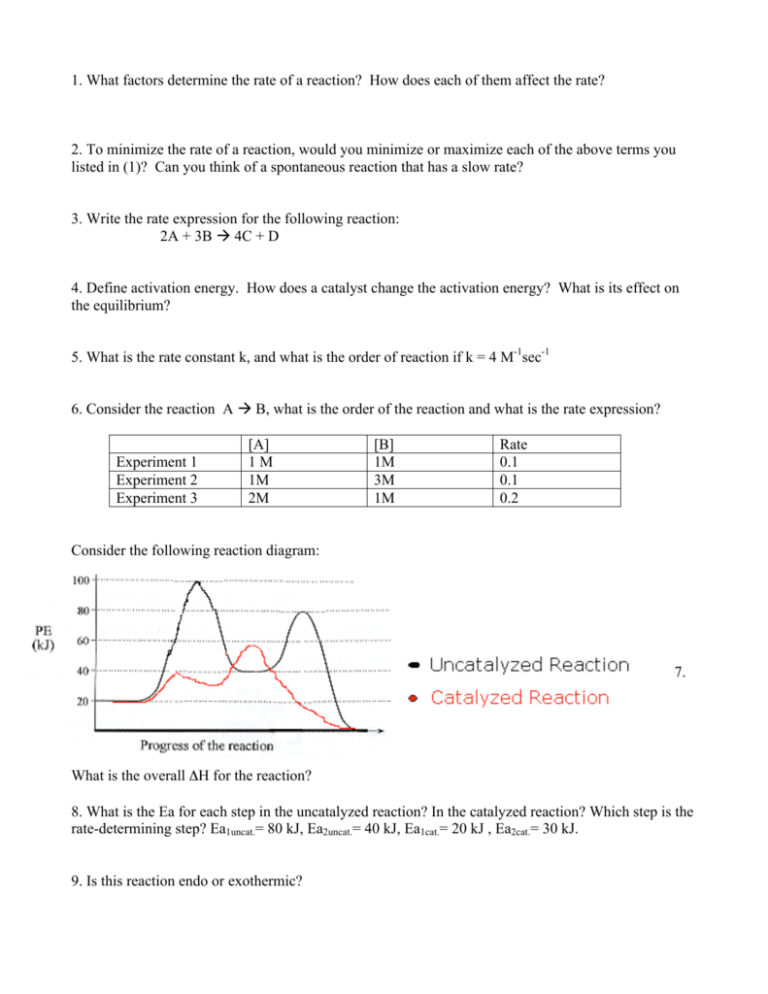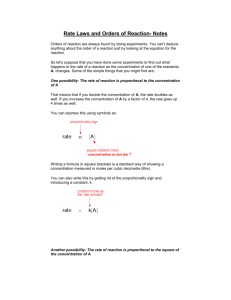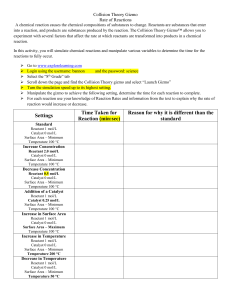Kinetics Worksheet Spring 09
advertisement

1. What factors determine the rate of a reaction? How does each of them affect the rate? 2. To minimize the rate of a reaction, would you minimize or maximize each of the above terms you listed in (1)? Can you think of a spontaneous reaction that has a slow rate? 3. Write the rate expression for the following reaction: 2A + 3B 4C + D 4. Define activation energy. How does a catalyst change the activation energy? What is its effect on the equilibrium? 5. What is the rate constant k, and what is the order of reaction if k = 4 M-1sec-1 6. Consider the reaction A B, what is the order of the reaction and what is the rate expression? Experiment 1 Experiment 2 Experiment 3 [A] 1M 1M 2M [B] 1M 3M 1M Rate 0.1 0.1 0.2 Consider the following reaction diagram: 7. What is the overall ΔH for the reaction? 8. What is the Ea for each step in the uncatalyzed reaction? In the catalyzed reaction? Which step is the rate-determining step? Ea1uncat.= 80 kJ, Ea2uncat.= 40 kJ, Ea1cat.= 20 kJ , Ea2cat.= 30 kJ. 9. Is this reaction endo or exothermic? 10. Which of the following statements is true? If any are false, correct them to make them true. a. A catalyst is always consumed in the overall reaction. b. A catalyst must always be in the same phase as the reactants. c. A catalyst can change the course of a reaction and allow different products to be produced. 11. Which of the following reactions appears to involve a catalyst? If so, is it homogenous or heterogenous? a. CH3CO2CH3(aq) + H2O(l) CH3COOH(aq) + CH3OH(aq) b. H2(g) + I2(g) 2HI(g) c. 2 H2(g) + O2(g) 2H2O(g) d. H2(g) + CO(g) H2CO(g) 12. Which of the following regarding catalysts is false? a. The concentration of a catalyst can appear in the rate law. e. A catalyst increases reaction rate by lowering ΔHrxn. f. A catalyst promotes a reaction by orienting the reacting partners in favorable positions. g. The Ea for a reaction never changes. h. Catalysts are usually very specific in the substrates they work with and the reactions they promote. i. Enzymes, radicals (photons), acids, bases and metals are all famous catalysts. 13. For the reaction of NO and O2 at 660K, 2NO(g) + O2(g) 2NO2(g) [NO] mol/L 0.010 0.020 0.010 a. b. c. d. [O2] mol/L 0.010 0.010 0.020 Rate disappearance of NO (mol/L*s) 2.5 x 10-5 1.0 x 10-4 5.0 x 10-5 Determine the order of reaction for each reactant. Write the rate equation for the reaction. What is the rate constant? What is the rate when [NO] = 0.025 M and [O2] = 0.05 M? 14. Nitryl fluoride is an explosive compound that is made by the oxidation of nitrogen dioxide with fluorine. 2NO2(g) + F2(g) 2NO2F(g) [NO2] mol/L 0.0010 0.0020 0.0020 0.0020 [F2] mol/L 0.0050 0.0050 0.0020 0.0020 [NO2F] mol/L 0.0020 0.0020 0.0020 0.0010 Rate disappearance of NO (mol/L*s) 2.0 x 10-4 4.0 x 10-4 1.6 x 10-4 1.6 x 10-4 a. What is the rate law for the reaction? b. What is the order of the reaction with respect to each reactant and product? c. Calculate the rate constant k. 15. Which of the following factors will affect the rate of a reaction? 2. Concentration of reactants 3. temperature 4. catalyst 5. physical phase i. I, II, III, IV ii. I, II only iii. I, II, II only iv. None of above 16. Which of the following statements regarding kinetics is true? a. Reaction orders must be integer values b. Zeroth order processes are dependent on reactant concentration c. The power n in the following rate expression has no direct relation to the coefficient in the balanced chemical equation: aA products; Rate = k[A]n a. I only b. II and III c. III only d. None are true 17. Given the following reaction: What is the rate constant k for the first order decomposition of N205 (g) at room temperature if the half life at room temperature is 4.03 x 10-4 s? 18. After one day, what percentage of N205 (g) molecules will NOT have reacted after one day? 19. 2 NO(g) + 2H2 (g) --> N2 (g) + 2 H2O(g) For the above reaction, it is observed that when the concentration of hydrogen gas is cut in half, the rate of the reaction is also cut in half. When the concentration of NO is multiplied by 10, the rate of the reaction increases by a factor of 100. Write the rate expression for this reaction. a) Rate = k[NO]^2[H2]^2 b) Rate = k[NO]^2[H2] c) Rate = k[NO][H2] 20. The reaction FCl)2 --> FClO(g) + O(g) is first order with a rate constant of 6.76 x 10^-4/s at 322 C. What is the half life of the reaction at 322 C? a) 3.03 x 10^3 s. b) 1.03 x 10^-3 s. c) 1.03 x 10^3 s. 21. For the reaction in question 6: If the initial partial pressure of FClO2 (g) in a container at 322 C is 0.040 atm, how long will it take to fall to 0.010 atm? a) 2.06 x 10^3 s b) 1.06 x 10^6 s c) 103 x 10^3 s ci) 22. HO2 is a highly reactive chemical species that plays a role in atmospheric chemistry. The rate of the gas phase reaction 2 HO2 --> H202 + O2 is second order in [HO2], with a rate constant of 1.4 x 10^9L/(mol s) at room temperature. Suppose some HO2 with an inital concentration of 2.0 x 10^8 M could be confined at room temperature. Calculate the concentration that would remain after 1.0 s, assuming no other reactions take place.







